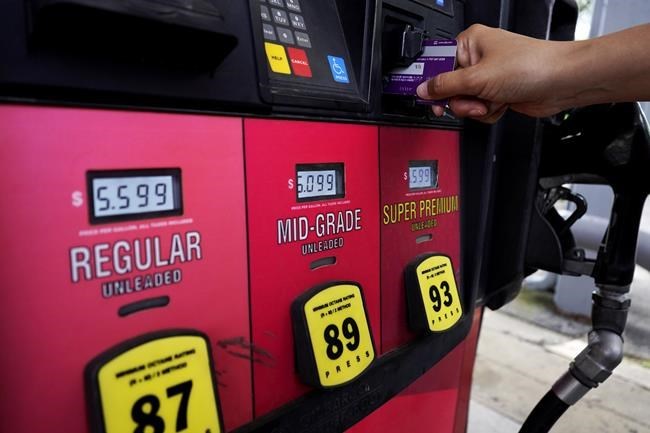WASHINGTON (AP) ŌĆö The U.S. economy shrank from April through June for a second straight quarter, contracting at a 0.9% annual pace and raising fears that the nation may be approaching a recession.
The decline that the Commerce Department reported Thursday in the gross domestic product ŌĆö the broadest gauge of the economy ŌĆö followed . Consecutive quarters of falling GDP constitute one informal, though not definitive, indicator of a recession.
The pointed to weakness across the economy. Consumer spending slowed as Americans bought fewer goods. Business investment fell. Inventories tumbled as businesses slowed their restocking of shelves, shaving 2 percentage points from GDP.
Higher borrowing rates, a consequence of the Federal Reserve's series of rate hikes, clobbered home construction, which shrank at a 14% annual rate. Government spending dropped, too.
The report comes at a critical time. Consumers and businesses have been struggling under the weight of punishing inflation and higher loan costs. On Wednesday, the Fed by a sizable three-quarters of a point for a second straight time in its push to conquer the .
The Fed is hoping to achieve a notoriously difficult : An economic slowdown that manages to rein in rocketing prices without triggering a recession.
Apart from the United States, the global economy as a whole is also grappling with high inflation and weakening growth, especially after Russia's invasion of Ukraine sent energy and food prices soaring. , appears especially vulnerable to a recession.
In the United States, the inflation surge and fear of a recession have and , which is . And with the November midterm elections nearing, AmericansŌĆÖ discontent has and could increase the likelihood that the Democrats will lose control of the House and Senate.
Fed Chair Jerome Powell and many economists have said that while the economy is showing some weakening, they doubt itŌĆÖs in recession. Many of them point, in particular, to a still-robust labor market, with and an uncommonly low , to suggest that a recession, if one does occur, isn't here yet.
ŌĆ£The back-to-back contraction of GDP will feed the debate about whether the U.S. is in, or soon headed for, a recession," said Sal Guatieri, senior economist at BMO Capital Markets. ŌĆ£The fact that the economy created 2.7 million payrolls in the first half of the year would seem to argue against an official recession call for now."
Still, Guatieri said, ŌĆ£the economy has quickly lost steam in the face of four-decade high inflation, rapidly rising borrowing costs and a general tightening in financial conditions.ŌĆØ
In the meantime, Congress may be moving toward approving action to fight inflation under by Senate Majority Leader Chuck Schumer and Sen. Joe Manchin, a West Virginia Democrat. Among other things, with pharmaceutical companies, and the new revenue would be used to lower costs for seniors on medications.
In the wake of ThursdayŌĆÖs government report, Biden dismissed any notion that the data depicted an economy in recession. The administration has stressed that solid job growth and low unemployment show that the U.S. economy is still growing despite two consecutive quarterly declines in GDP. Speaking from the White House, Biden leaned on remarks that Powell and other economic leaders have made.
ŌĆ£Both Chairman Powell and many of the significant banking personnel and economists say weŌĆÖre not in recession,ŌĆØ the president said.
The governmentŌĆÖs first of three estimates of GDP for the April-June quarter marked a drastic weakening from the . That was the fastest calendar-year expansion since 1984, reflecting how vigorously the economy roared back from the brief but brutal pandemic recession of 2020.
But since then, the combination of mounting prices and higher borrowing costs have taken a toll. The Labor DepartmentŌĆÖs in June from a year earlier, a pace not matched since 1981. And despite widespread pay raises, prices are surging faster than wages. In June, average hourly earnings, after adjusting for inflation, slid 3.6% from a year earlier, the 15th straight year-over-year drop.
Americans are still spending, though more tepidly. Thursday's report showed that consumer spending rose at a 1% annual pace from April through June, down from 1.8% in the first quarter and 2.5% in the final three months of 2021.
Spending on goods like appliances and furniture, which had soared while Americans were sheltering at home early in the pandemic, dropped at a 4.4% annual rate last quarter. But spending on services, like airline trips and dinners out, rose at a 4.1% rate, indicating that millions of consumers are venturing out more.
Before accounting for surging prices, the economy actually grew at a 7.8% annual pace in the April-June quarter. But inflation wiped out that gain and then some and produced a negative GDP number.
Against that backdrop, Americans are losing confidence. Their assessment of economic conditions six months from now has reached its lowest point since 2013, according to the Conference Board, a research group.
The FedŌĆÖs hikes have already led to higher rates on credit cards and auto loans and to in the past year, to 5.5. .
Even with the economy recording a second straight quarter of negative GDP, many economists do not regard it as constituting a recession. The is the one determined by the National Bureau of Economic Research, a group of economists whose defines a recession as ŌĆ£a significant decline in economic activity that is spread across the economy and lasts more than a few months.ŌĆØ
The committee assesses a range of factors before publicly declaring the death of an economic expansion and the birth of a recession ŌĆö and it often does so well after the fact.
ŌĆ£If we arenŌĆÖt yet in a recession, we soon will be,'' said Joshua Shapiro, chief U.S. economist for the economic consulting firm Maria Fiorini Ramirez Inc. ŌĆ£An economy rapidly losing momentum combined with aggressive monetary tightening is not a recipe for a soft landing or any other type of happy ending.''
___
Associated Press writer Josh Boak contributed to this report.
Paul Wiseman, The Associated Press



